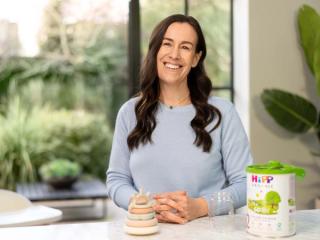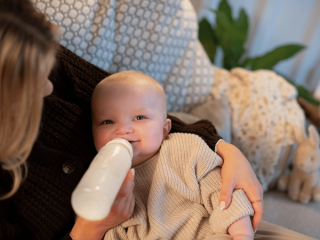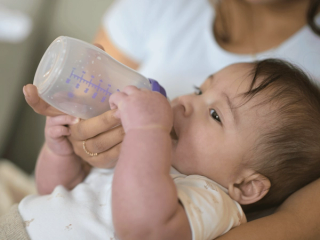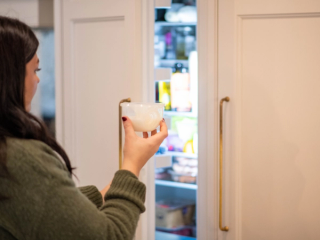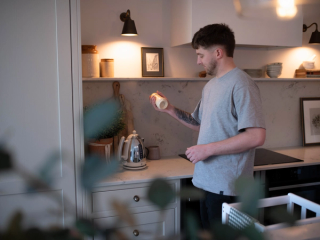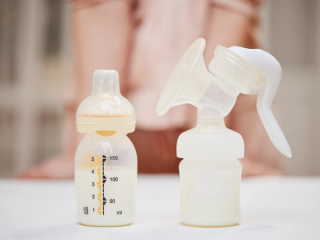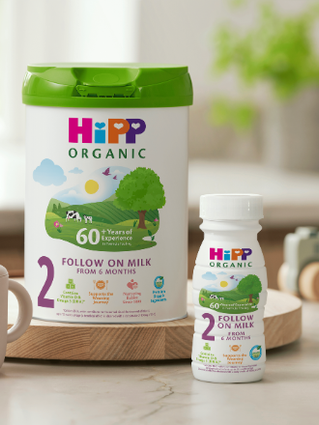
- Home
- Advice Hub
- Baby
- Baby Feeding
- Difference Between Powder Vs Ready To Feed
The difference between powder vs ready to feed
Discover the difference between powdered and ready-to-feed infant formula, nutrition, safety, cost, convenience & what suits your baby best.
What are the differences between powder formula vs ready to feed? At an ingredients level, very little – but there are pros and cons to each that are worth considering when you’re making your choice. From price to convenience, shelf life to environmental impact, we’ve created this handy guide to give you a comparison between powder and ready to feed formula milks, drawing on more than 60 years’ experience in formula feeding.
What is powder formula?
Powdered formulas are dried formula milks that are prepared following the prep instructions on pack with cooled, boiled water that provides all the nutrition your baby needs from birth.
You might be wondering what baby formula is made of. Today’s standard formula milks are usually based on either cows’ milk or goats’ milk, with carefully adjusted carbohydrate, protein and fat levels, and enriched with specific levels of vitamins, minerals and nutrients. In its powdered form, you simply mix with water in accordance with the instructions on the packaging to make up a feed for your baby.
What is ready to feed formula?
Ready to feed formula is already mixed and – as the name suggests – ready to give to your baby. You can choose to warm it up or feed as is, please check the preparation instructions for guidance. It comes in individual bottles and can be poured into your baby’s preferred (pre-sterilised) bottle or beaker. Ready to feed bottles are single use, as they have been made up in sterile conditions to ensure the milk is safe for consumption for the duration of its shelf life.
Nutritional comparison: powder vs ready to feed
Both powdered and Ready to Feed formula provide the same nutrition for your baby, offering an alternative for parents who are combination feeding, or who cannot or choose not to breastfeed.
All formula milks have to meet very strict compositional regulations, so you can be sure your baby will get the key nutrients, in the right quantity, from whichever format of formula you use. However, sometimes there’s a very slight difference between powdered formula and Ready to Feed when it comes to the sources and values of different vitamins and minerals. You can always check the ingredients on the packs to see, but not many babies notice the difference.
Powder Formula vs Ready-to-Feed cost comparison
Using Ready to Feed formula will cost more than making up a feed with a powdered formula. Across all brands, the price per 100 ml feed is higher due to the additional manufacturing, packaging and shipping costs. For this reason, many people opt to use powdered formula milks for day-to-day and ready to feed for days out or when making up a feed is difficult.
Things to consider
In addition to the cost, there are other things to consider when comparing powder vs ready to feed formula.
Convenience
Ready to Feed formula is incredibly handy. Ready to pour into a sterilised bottle or beaker, it’s ideal for days out, fuss-free night feeds, or any occasion when you’re away from home (and the necessary facilities for making powdered formula safely.) Powdered formula requires access to freshly boiled water, which can be difficult when you’re travelling – and makes your nappy bag even heavier if you’re carrying it around with you! There are also limits on how long you can keep a bottle made up from powdered formula, which can be restricting on days out.
Storage: Ready to feed vs powdered formula
Another consideration is space. If you choose to mainly use Ready to Feed formula, you’ll need to set aside quite a lot of cupboard space. The containers are bulkier than the tins of powdered formula. In fact, one 800g pack of powdered HiPP Organic Follow on Milk will make up nearly six litres of formula, which is about the same as thirty 200ml Ready to Feed bottles of the same formula!
Powder vs ready to feed FAQs
We know you always want to do the best by your baby, so we have tried to answer all the most common questions about powdered formula milk and ready to feed below. If you have specific questions about our products, you can contact us at any time. If you have any concerns about your baby, always speak to a healthcare professional.
Our first infant milk is suitable from birth, whether you’re using ready to feed or powder formula. The difference in ingredients is very slight, and your baby may not even notice but please always check the packaging for allergy information. However, if you have concerns, you can try introducing the new formula slowly – perhaps changing one feed a day every few days and working your way up from there. See our article on changing formula milks for more advice.
Many babies will not notice a difference when changing from ready to feed formula to powdered formula – especially if you continue using the same bottle and teat as before. If they seem upset by the change, take it slowly, changing over one feed at a time rather than all feeds all at once. You could even start a feed with one type of milk and switch to the other type (in a separate, clean, sterilised bottle) part way through to see if that helps them transition.
Powdered formula milk is far more economical than Ready to Feed milk, simply because it is cheaper to manufacture and sell than Ready to Feed, which has more logistical requirements. As an example, one 800g pack of powdered HiPP Organic Follow on Milk costs £13.50 and will make up nearly six litres of formula. The equivalent quantity in Ready to Feed bottles would cost more than £30.
Powdered formula is more economical, takes up less space in your cupboard, and has a lower environmental impact that ready to feed formula.
Both powdered and ready to feed formula milks are nutritionally tailored for little tummies and should not have any impact on your baby’s digestion or health. Some babies transition quickly from one formula to another, while others need more time – in which case we recommend following the advice in our guide to changing formula milks. If you have any concerns about your baby’s digestion or health, always talk to a healthcare professional.
Conclusion
Choosing the right formula for your baby can feel daunting, but when it comes to ready to feed vs powdered formula milk you don’t need to worry that one is better for your baby than the other – both meet government regulations regarding the proper nutrition for your baby. The best choice for you is always what works best for your family – and that might mean using both interchangeably depending on your circumstances.
If you have any concerns about your baby’s feeding patterns, growth, or digestion, always talk to your healthcare professional.
Important Notice
We recognise that breastfeeding is best, providing many benefits to both mothers and infants. We also recognise that every parenting journey is unique, and we are here to support you through this journey, however you choose to feed your baby.
If you choose to breastfeed it is important that you eat a healthy well-balanced diet in preparation for and during breastfeeding. Before deciding to combination or formula feed your baby, note that reducing or stopping breastfeeding can be difficult to reverse. Babies feed on demand, so replacing breastfeeding with infant formula milk may reduce your supply. Formula feeding has both social and financial implications. Talk to your midwife or health visitor for guidance and support.
If you choose to use formula milk, make sure you choose the right milk for your baby’s age and prepare and store it according to the instructions on the packaging. Not doing so may make your baby ill. Infant formula is a nutritionally complete breastmilk substitute that can be used from birth. From 6 months you can choose to use follow on milk as part of a mixed diet and from 12 months you have the option to move onto growing up milk alongside a balanced diet.
